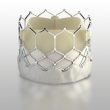Discover the most read scientific articles on interventional cardiology of 2022 in our website. The FDA Approves Intravascular Lithotripsy for Calcified Lesions The US Food and Drug Administration (FDA) has cleared the shockwave lithotripsy system to treat severely calcified plaque lesions. Is Epinephrine Superior to Adenosine in No-REFLOW? In patients with acute coronary syndrome, no-reflow prevalence is 32%. Different drugs—such as adenosine, verapamil,<a href="https://solaci.org/en/2023/01/05/interventional-cardiology-the-most-read-articles-of-2022-in-solaci-org/" title="Read more" >...</a>
Real-World Results of Different Devices for TAVR
Transcatheter aortic valve replacement (TAVR) keeps growing in terms of the development of new devices, more extensive operator experience, and enhanced procedure planning. Nowadays, there are multiple device options, which depend on patient characteristics and operator experience. Two-arm studies compared these devices, analyzing the potential benefits of a certain valve over the others. This multicenter<a href="https://solaci.org/en/2023/01/04/real-world-results-of-different-devices-for-tavr/" title="Read more" >...</a>
Clinical Implications of the Presence of HALT in TAVR Patients: 5-Year Follow-Up
The duration of percutaneous aortic valve implants can be increasingly observed over time, regardless of their corresponding surgical risk. In the follow-up of different registries, the presence of subclinical valvular thrombosis, evidenced in tomographic studies as an increase in valvular thickness with hypoattenuation (a term known as HALT), was observed from protocolized images. This subclinical<a href="https://solaci.org/en/2023/01/03/clinical-implications-of-the-presence-of-halt-in-tavr-patients-5-year-follow-up/" title="Read more" >...</a>
Is the PASCAL Device Effective against MitraClip?
Mitral regurgitation (MR) is the most common valvulopathy and full medical treatment at maximal tolerated doses has been shown quite effective to treat it. However, its limited in a group of patients that require valve intervention. At present, the ideal treatment is surgical valve replacement, which is in many cases is not viable because of<a href="https://solaci.org/en/2022/12/30/is-the-pascal-device-effective-against-mitraclip/" title="Read more" >...</a>
We Should Treat Significant Stable CAD in Patients Undergoing TAVR
Aortic stenosis is associated to significant coronary artery disease (CAD) in nearly 50% of cases. When we decide to treat aortic disease using surgery, it has been established we should also treat heart disease. However, when using transcatheter aortic valve replacement (TAVR), this is still unclear, given that in many occasions we see stable lesions<a href="https://solaci.org/en/2022/12/30/we-should-treat-significant-stable-cad-in-patients-undergoing-tavr/" title="Read more" >...</a>
Is Clopidogrel Monotherapy Safe After a Month of Dual Antiplatelet Therapy in Diabetic Patients?
Currently, many randomized studies have suggested that short-term dual antiplatelet therapy (DAPT) followed by monotherapy reduces bleeding without increasing major cardiovascular events after percutaneous coronary intervention (PCI). A meta-analysis of six randomized studies has shown this benefit using ticagrelor monotherapy after short DAPT. However, there is no data on the results of clopidogrel monotherapy. Researchers<a href="https://solaci.org/en/2022/12/27/is-clopidogrel-monotherapy-safe-after-a-month-of-dual-antiplatelet-therapy-in-diabetic-patients/" title="Read more" >...</a>
How Do We Manage Antiaggregation in BARC I Bleeding after AMI?
Dual antiplatelet therapy (DAPT) after acute myocardial infarction (AMI) has been shown useful to reduce thrombotic events, but one of its downsides is bleeding, especially in elderly patients. BARC bleeding type I, also called nuisance bleeding (NB), is of low frequency, but its evolution and impact remain unclear, as does its management. A subanalysis of<a href="https://solaci.org/en/2022/12/07/how-do-we-manage-antiaggregation-in-barc-i-bleeding-after-ami/" title="Read more" >...</a>
Mitral Trial: 2-Year Followup
At present, an important group of patients with mitral valve disease are at high surgical risk, especially those with deteriorated bio-prosthesis, severe mitral annulus calcification or those who had received mitral annuloplasty. Percutaneous treatment with balloon expandable valves is a valid option to treat these patients, seeing as their 30 day and one-year outcomes look<a href="https://solaci.org/en/2022/12/07/mitral-trial-2-year-followup/" title="Read more" >...</a>
P2Y12 Inhibitor Monotherapy vs Aspirin: Results of a Network Meta-Analysis
Revascularization and antiaggregation guidelines have typically recommended aspirin (AAS) as first choice for secondary prevention of cardiovascular events after DES stenting. However, these past few years this strategy has been called into question, seeing as studies have shown the superiority of P2Y12 inhibitor monotherapy (IP2Y12) with clopidogrel or ticagrelor. There is little data comparing both<a href="https://solaci.org/en/2022/12/05/p2y12-inhibitor-monotherapy-vs-aspirin-results-of-a-network-meta-analysis/" title="Read more" >...</a>
Severe Mitral Regurgitation and Cardiogenic Shock: Is Edge-to-Edge a Valid Strategy?
At present, cardiogenic shock continues to present high mortality despite the new treatments and ventricular assistance devices available in some centers. In this group, the presence of severe mitral regurgitation (MR) is around 5% and, on many occasions, it cannot be treated with surgery because of hemodynamic conditions. Edge-to-edge repair has been looked at by<a href="https://solaci.org/en/2022/11/30/severe-mitral-regurgitation-and-cardiogenic-shock-is-edge-to-edge-a-valid-strategy/" title="Read more" >...</a>









